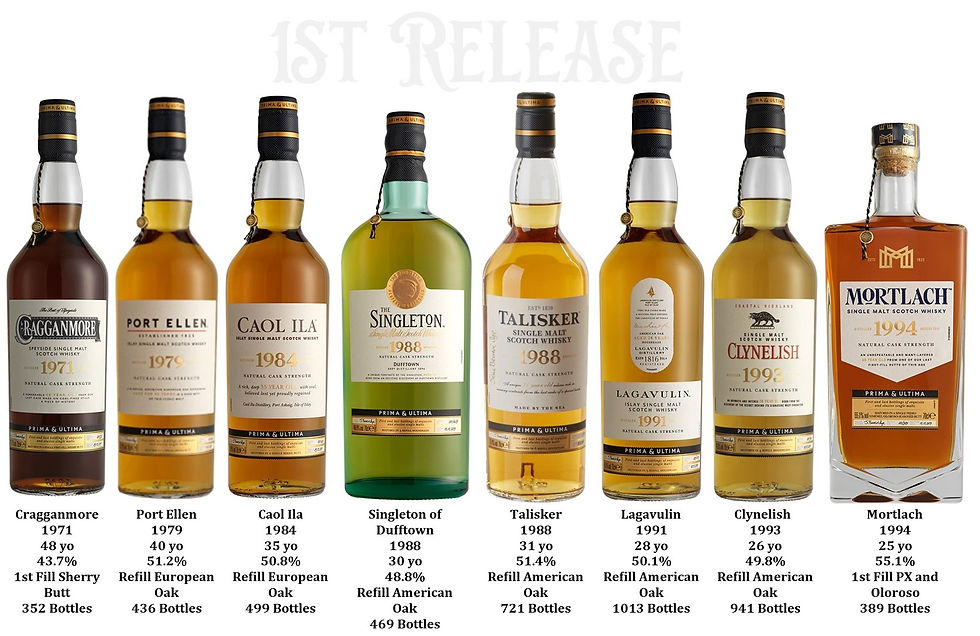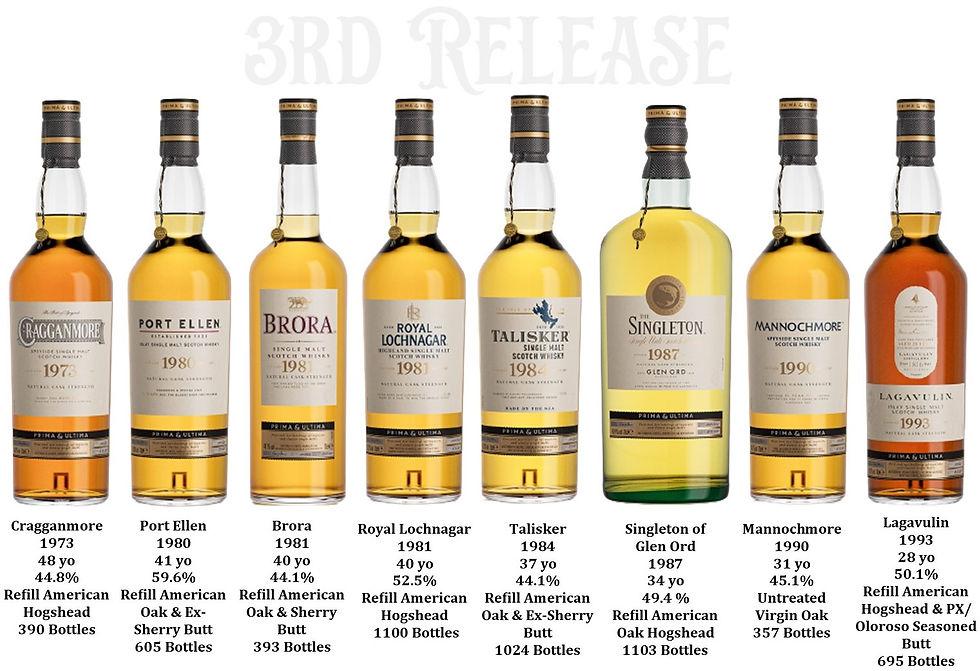Please be aware that this article is an opinion post affected by the writer's personal opinion. All the numbers in this article have been acquired by cross-checking information made available about the whisky releases including batch sizes and average costs.

Image by The Whisky Ardvark
For many whisky lovers, Diageo's Special Releases bottled at cask strength have been the event of the year since 2001. But in recent years, those releases have felt less than special. Not because there's something wrong with the whiskies but because the rare expressions from closed distilleries like Brora and Port Ellen have been missing. Little by little, the Special Releases have become almost predictable, and whisky fanatics have lost interest in the upcoming line-up.
In mid-2020, a new collection called Prima & Ultima, meaning 'First & Last', was launched. This 8-bottle set has the appeal and feel of the yearly years of the Special Releases when most whiskies were old enough to order their own whisky (18+). But why create a new collection that overshadows the existing one?
Recently, Diageo has concentrated its attention on creating even more collections that can be deemed collectable. With the release of sets like the Game of Thrones and Special Releases with a theme and eye-catching graphics, it seems like Diageo needed a new home for their sought-after, rare whiskies. Enter the Prima & Ultima.
Many things have changed since the launch of the Special Releases in 2001. With whisky's ever-growing popularity, there are more taste buds to soothe. Diminishing stocks of old whiskies and the inevitable perish of whiskies from closed distilleries are affecting prices that only the financially blessed can soon afford. Most likely, Diageo doesn't have enough old quality stock to release them as part of Special Releases, so in recent years, consumers have been presented with cheaper and younger options that appear special mainly because they are marketed that way.
So, What Exactly Is The Prima & Ultima Collection About?
The idea behind Prima & Ultima was to bottle whiskies that were the first and last of their kind - the last whiskies distilled and casks matured from the years displayed. Some whiskies might have been distilled on the first or last day of distillation from the distillery that year or mark the end of an era with a significant meaning. In reality, the concept of "first and last" can be stretched out to mean anything (or nothing).
All the expressions under Prima & Ultima are more than 25 years old, with an average age of 35. Each release also has a different curator, whose job it is to choose what whiskies will be included. So far, there have been 3 releases - 1st and 2nd released mainly in Europe, and 3rd made available worldwide with some limitations.
The Prima & Ultima Collection was designed with a high-end private collector in mind who wishes to build up their rare whisky stash. This always makes us a little wary because it implies that the whiskies were never bottled to drink but to have as trophies. But Diageo is investing in these expensive bottlings since that's where the money currently is.
The first set was released in June 2020 and was curated by Johnnie Walker's Master Blender, Dr Jim Beveridge OBE.

Image by The Whisky Ardvark
The 2nd Release was chosen by Master Blender Maureen Robinson to mark important times in her 40-year career with Diageo.

Image by The Whisky Ardvark
The 3rd Release was curated by Master Blender Craig Wilson to reflect his long career in whisky - 'nurturing and restoring the rare spirits of Diageo's distilleries'.

Image by The Whisky Ardvark
Prima & Ultima's batch sizes are significantly smaller than the Special Releases. The 1st Release of Port Ellen back in 2001 had a batch size of 6,000 bottles, but only 436 bottles of Port Ellen were made available as part of the 1st Release of the Prima & Ultima in 2020. We feel that the main reason for the new collection is that there is not enough whisky to go around.
Diageo has invested greatly in the appearance of the Prima & Ultima collection. The sets follow a look of luxury in a bottle with its gold and white simplicity. For example, compared to the 2009 Special Releases, the new collection is more coherent with a clear family resemblance. And that's why Prima & Ultima is sold in many places as sets that dare you to 'collect them all'. Of course, not all bottles are sold as part of a set since batch sizes per expression range from 352 to 1103 bottles.

Image by The Whisky Ardvark
Prima & Ultima - 'Rare Malts at Heart?'
With time, everything changes. Brands and even collections go through natural evolution to meet the needs of consumers. We need to look back in time and remember what the whisky drinkers wanted in the 90s when the Rare Malts were created.
The first single malts were released in the 1960s, followed by overproduction and distillery closures in the 80s. In 1989, the predecessor of Diageo launched the Classic Malts, introducing a new concept to whisky lovers. They picked 6 distilleries from their portfolio to represent different whisky regions in Scotland - Oban (Highlands), Talisker (Islands), Lagavulin (Islay), Glenkinchie (Lowlands), Cragganmore (Speyside), and Dalwhinnie (Highlands). These distilleries would become the poster children for the styles produced in Scotland. In the end, what they were was a marketing success.
To continue their creation of sets, in 1995, Diageo launched the Rare Malts. These whiskies were some of the first official cask-strength single malts whiskies ever released, making them rare in nature. But the average whisky consumer of the 90s wasn't that interested in single malts - especially collecting them based on rarity. Diageo didn't break through the concept of collectable whiskies until the first Special Releases in 2001. Due to the growing interest from consumers, the Special Releases became a success that overshadowed the Rare Malts. As a result, the Rare Malts were discontinued in 2005.
The Rare Malts Selection included over 100 expressions of cask-strength whiskies ranging from 18 to 35 years old. The average of these bottlings was 23 years (~82% of the releases aged between 20 and 25). Produced in small batches, the Rare Malt expressions were released with a turnout of an average of 1500 bottles each.
The new Prima & Ultima collection has characteristics that can be dated back to the Rare Malts, at least according to Master Blender Craig Wilson. We do feel that he is consciously skipping a chapter by dismissing the Special Releases that lay in between because, in the eyes of many whisky fanatics, the name 'Rare Malts' is still highly valued in the community. Comparing them to Rare Malts instead of Special Releases today has a better emotional response and association.

Image by The Whisky Ardvark
In our opinion (and by the average age of bottlings), the Prima & Ultima collection reminds us more of the early Special Releases than the Rare Malts. But with the comparison to Rare Malts, Diageo might be trying to tap into the memories of the 90s whisky drinker for that wow effect of something shiny and new.
The Decline of the Special Releases
Diageo - the Master of Sets - has been making a great profit in 2022 after sales declined during the pandemic. People are investing in whisky and spending more money to get quality over quantity. Many core range releases have increased by sometimes doubling in price (we're looking at you, Talisker 18yo), and charging more for what used to be 'affordable' has become an unsettling trend. Diageo has also had a trend of charging a premium for similar expressions from their core range when they are part of sets. For example, the core expression of Cragganmore 12yo costs ~£40, but Cragganmore 12yo SR 2019 has a price tag of £110. Even with the fact that one of them is bottled at cask strength, the price jump seems to be hard to swallow.
The major factors contributing to the price of whisky are its rarity (release size, remaining stock, age), the distillery's collectability, cask choices, and packaging. (If you're interested in reading more about these factors, please click here.)
For years the Special Releases were the top contenders in the rare whisky market. By 2017 it had become clear to some that something was going on with the Special Releases line-up that didn't quite meet the expectations. But it wasn't until 2019 that people attending the Special Releases tastings were left speechless - and not in a good way. The whiskies seemed far less special and younger than they had expected even with the lowered standards. And they were right to feel that way.
In the last 5 years or so, the market for younger whiskies has been on the rise. Not only because consumers are getting used to them but because, with the growing demand for whiskies, the producers can turn over stock quicker and still make a good profit. But in our opinion, that's not what the Special Releases were created to do. You can't first establish what 'Special' refers to as a high-standard old and rare whisky and then call young and cheap whiskies 'Special' under the same concept.
Average Current Values of Full Sets (2022) & Ages of the Special Releases
Please note that we have excluded the year 2001 since only 3 expressions were released. We are also highly aware that many expressions will increase in value over the years, and as a comparison, we have also included the average age of whiskies released.

Image by The Whisky Ardvark
Looking at the current value of the whiskies released under the Special Releases label, it's clear that even Diageo has lost its respect for the series. The rarity of the whiskies has declined, and the real stars by flavour have disappeared. Taste is subjective, but for us, the last 'hero' of the Special Releases saw the light in 2017 - Convalmore 1984 32yo, which was beautiful but the only star of the year.
We can only think about why Diageo would try to keep the Special Releases alive, tarnishing its past reputation, by releasing whiskies that are not as special as they used to be. Why didn't they call it quits and retire the name 'Special Releases' when it became clear that they didn't have enough stock to offer consumers something special? Diageo could have discontinued the line when it still had some of its past reputation left and launched a new series with its current storytelling theme. It is possible that getting rid of the event of launching the Special Releases every year would have been seen as a defeat and a missed opportunity, so dragging it on became inevitable.
If the Special Releases are kept alive as something special and affordable for everyone - AKA 'Poor Mans Specials' - it's time to wrap it up. With the Prima & Ultima launch, we wouldn't be surprised if Diageo finally decides to end the annual releases in the next few years. That's what they did with the Rare Malts back in 2005 when something better came along. (Well, overlapping by 5 years.) We do think the Prima & Ultima was created to help phase out the Special Releases - but that's just our opinion.
What are your thoughts about the Special Releases in the last few years? Have you had the chance to try the Prima & Ultima collection? Let us know in the comments below or with #whiskyardvark on social media.

.png)
Commenti